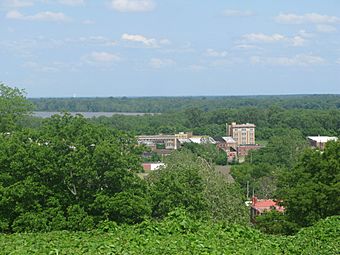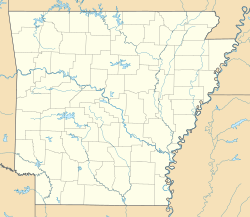Helena batteries facts for kids
Quick facts for kids |
|
|
Helena batteries
|
|

View of Helena from Battery C Park
|
|
| Location | Helena (present-day Helena-West Helena), Arkansas |
|---|---|
| Area | 10 acres (4.0 ha) |
| Built | 1863 |
| NRHP reference No. | 78000615 |
| Added to NRHP | December 1, 1978 |
The Helena batteries, also known as the Union batteries at Helena, are a group of old forts built in Helena-West Helena, Arkansas. These forts were quickly put together in 1863 by the Union army during the American Civil War.
The forts were made of earthworks, which are walls or mounds built from earth for defense. There were four main forts, called Battery A, B, C, and D. They were built on hilltops around the town. These batteries watched over the roads leading into Helena. They played a very important part in the Battle of Helena. This battle ended with a big win for the Union side. It helped the Union control the Arkansas side of the Mississippi River. Today, these batteries are listed on the National Register of Historic Places. They are part of the larger Helena Battlefield.
Contents
History of the Helena Batteries
Helena, Arkansas, is in a very important spot. It sits at the southern end of Crowley's Ridge. This high land gives great views over the Mississippi River. The Union army took control of Helena in 1862. They used it as a place to gather troops. From here, they supported the Siege of Vicksburg, Mississippi. This siege began in May 1863.
The Union soldiers built a circle of defenses around Helena. These defenses guarded the main roads into town. They also controlled the high ground above Fort Curtis. Fort Curtis was the Union's main base just west of Helena. The Union navy controlled the river. The USS Tyler warship was nearby. The defenses built by General Benjamin Prentiss included artillery batteries, rifle pits, and abatis. Abatis were felled trees used to block enemy movement.
In June 1863, Confederate leaders in Little Rock, Arkansas made a plan. They wanted to attack Helena by land. Their goal was to take back the town. This would cut off Union supplies. It would also help the city of Vicksburg, which was under attack.
Lieutenant-General Theophilus H. Holmes led the Confederate forces. They attacked Helena on July 4, 1863. This was the same day Vicksburg surrendered to the Union. General Prentiss had ordered the four batteries built in late June. This was because Confederate activity was increasing nearby.
The Confederate attack had problems. The Union defenders had cut down trees across the roads. This made it hard for the Confederates to move. Then, all four batteries fired on them. The Union Navy ships also fired their guns. The Confederates did manage to take Battery C. But fire from the other three batteries forced them back. An attack on Battery D reached its rifle pits. But the Confederates could not go any further. The Confederates had more than 1,600 soldiers hurt or killed. The Union forces had only 239. This was a big win for the Union.
Key Battery Sites
Battery A
Battery A is located on a 4-acre piece of land. It sits on Rightor Hill. This is northwest of where Adams and Columbia Street meet. This battery watched over the Old St. Francis Road and the Sterling Road. Soldiers from the 33rd Missouri and the 29th Iowa defended it. They easily pushed back forces led by General John S. Marmaduke. These forces were trying to capture Battery A.
Battery B
Battery B is on a 1-acre piece of land. It is on Carvill Hill. This is northeast of where Liberty Street and Summit Road meet. It is also a few hundred yards southwest of Battery A. This battery watched over the Upper St. Francis Road. Soldiers from the 33rd Missouri manned it. Battery B was never directly attacked. It fired on Confederate forces trying to reach Batteries A and C.
Battery C
Battery C was on a place called Graveyard Hill. This is south of Clark and west of York Street. Today, it is a city park. Not much is left of the intense fighting here. A large part of its eastern side was removed in the 1930s. This was for building levees. Also, erosion has worn away most of the earthworks and rifle pits.
Soldiers from the 33rd Missouri manned Battery C. It helped the other batteries by firing its guns early in the battle. Then, the Confederates attacked it directly. Union forces disabled their large guns before pulling back. They set up a new defense line about 250 yards east of the hill. This area saw very heavy fighting. The other three batteries and the Union gunboats fired on it. Confederates tried to push on to Fort Curtis and Battery D. But they were stopped. They left Battery C before they could bring up their own cannons.
Battery D
Battery D is on Hindman Hill. It is off Military Road southwest of downtown Helena. This battery watched over the main road between Helena and Little Rock. Of the four batteries, Battery D is the best preserved. Its earthworks and rifle pits can still be seen near the top of the hill.
Union soldiers from Iowa, Missouri, and Indiana manned this battery. It was the target of a Confederate attack. Arkansas forces led by Brigadier General James F. Fagan launched this attack at daybreak. They managed to get through three lines of rifle pits. This was despite heavy fire from batteries C and D. Reinforcements sent to help the attack from Battery C were pushed back. General Fagan was ordered to pull his men back. However, some of his men did not get the order. A group of Confederates was surrounded and captured.
See also


